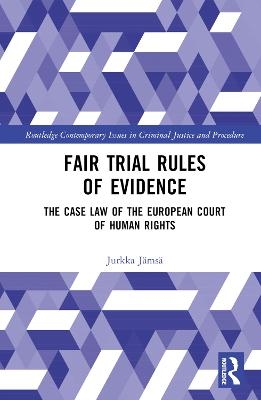
Fair Trial Rules of Evidence
The Case Law of the European Court of Human Rights
Seiten
2022
Routledge (Verlag)
978-1-032-31794-6 (ISBN)
Routledge (Verlag)
978-1-032-31794-6 (ISBN)
This book explores how the European Court of Human Rights approaches evidence and how its judgments affect domestic law. It examines key defence rights such as the right to adduce evidence, the right to disclosure, the privilege against self-incrimination and access to a lawyer, entrapment, and the right to cross-examine prosecution witnesses.
This book examines how the European Court of Human Rights approaches the matter of evidence, and how its judgments affect domestic law. The case law of the Court has affected many areas of law in Europe. One of these areas is the law of evidence, and especially criminal evidence. This work examines the key defence rights that may touch upon evidence, such as the right to adduce evidence, the right to disclosure, the privilege against self-incrimination and access to a lawyer, entrapment, and the right to cross-examine prosecution witnesses. It explains the relevant assessment criteria used by the Court and introduces a simple framework for understanding the various assessment models developed by the Court, including the Perna test, the Ibrahim criteria, and the sole or decisive rule. The book provides a comprehensive overview on the relevant case law, and will be a valuable asset for students and researchers, as well as practitioners, such as judges, prosecutors, and lawyers, working in the areas of criminal procedure and human rights.
This book examines how the European Court of Human Rights approaches the matter of evidence, and how its judgments affect domestic law. The case law of the Court has affected many areas of law in Europe. One of these areas is the law of evidence, and especially criminal evidence. This work examines the key defence rights that may touch upon evidence, such as the right to adduce evidence, the right to disclosure, the privilege against self-incrimination and access to a lawyer, entrapment, and the right to cross-examine prosecution witnesses. It explains the relevant assessment criteria used by the Court and introduces a simple framework for understanding the various assessment models developed by the Court, including the Perna test, the Ibrahim criteria, and the sole or decisive rule. The book provides a comprehensive overview on the relevant case law, and will be a valuable asset for students and researchers, as well as practitioners, such as judges, prosecutors, and lawyers, working in the areas of criminal procedure and human rights.
Jurkka Jämsä is a Junior Justice (asessori) in the Vaasa Court of Appeal, Finland.
Preface and acknowledgements, Table of cases, Table of abbreviations, 1. Introduction, 2. The right to a fair trial, 3. Rules of evidence, 4 Basic evidentiary rights, 5. The privilege against self-incrimination, 6. The prohibition of torture and inhuman or degrading treatment, 7. The prohibition of entrapment, 8. Other improperly obtained evidence, 9. The right to cross-examine prosecution witnesses, 10. Conclusion, Bibliography, Index
| Erscheinungsdatum | 14.09.2022 |
|---|---|
| Reihe/Serie | Routledge Contemporary Issues in Criminal Justice and Procedure |
| Verlagsort | London |
| Sprache | englisch |
| Maße | 156 x 234 mm |
| Gewicht | 453 g |
| Themenwelt | Recht / Steuern ► Allgemeines / Lexika |
| Recht / Steuern ► EU / Internationales Recht | |
| Recht / Steuern ► Strafrecht ► Kriminologie | |
| Recht / Steuern ► Strafrecht ► Strafverfahrensrecht | |
| Sozialwissenschaften | |
| ISBN-10 | 1-032-31794-9 / 1032317949 |
| ISBN-13 | 978-1-032-31794-6 / 9781032317946 |
| Zustand | Neuware |
| Haben Sie eine Frage zum Produkt? |
Mehr entdecken
aus dem Bereich
aus dem Bereich
wie wir unsere Mimik und verborgene Körpersignale entschlüsseln
Buch | Hardcover (2022)
Droemer (Verlag)
CHF 27,95


